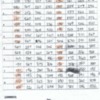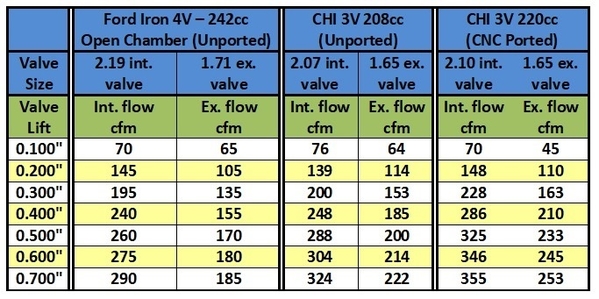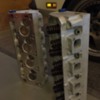I am a new member here and would like to say hello to all. Unfortunately I do not own a Pantera, but I am a huge Ford enthusiast. I have a 1970 Mustang sportsroof. The 351 Cleveland locked up on me one evening a little over a year ago while checking out the rods. LOL. Anyway, since then I have purchased Scott Cook heads and duel plane intake. I took the engine to my machinist that has been doing work for me the last 30 years (and yes he is a Ford specialist). He advised me not to spend the money it would take to verify the block, and to find that it was not a good candidate for a 393ci Cleveland, or to take the chance on hurting those beautiful Scott Cook heads. He laughs, and says there are two kind of OE Clevelands. Ones that have cracked cylinders and those that are going too. This leads me to my question, which after market block to go with. I see that MME has been producing blocks since 2012 or so, but can't find any reviews or input from other machinist and does not have any cast blocks in stock at this time. Or the new TMEYER block which has 75 to 100 people on his waiting list for iron blocks that are still in the making. If MME has been producing blocks since 2012 why are there so many people waiting on TMEYER blocks (am I just not listening). I am not familiar with either MME or TMEYER, so your help and input would be greatly appreciated. Thanks in advance. Joe
Replies sorted oldest to newest
Do a search here for MME. There was a spat detailed here a while ago over an engine they built. Though that seemed to be a valve train geometry issue (and perhaps customer service issue, read to decide for yourself). I don't remember what block was used.
I too might be in the market for an aftermarket block, but the TMeyer offerings always seem 3 months away, and like you I can't find anything concrete on other options - disappeared websites, aged info on websites, info split between social media and websites, and ghosts of projects past.
There are other blocks that can be adapted, e.g. Fontana (and Arrow, and DART). They may be hard to source.
From someone who is running a Fontana....
"The Fontana block is actually a cross between the Cleveland block and the Windsor block. It uses a Cleveland crank shaft and oil pan, but has a Windsor style front timing cover and the intake manifold is a Windsor type. They were made in both 9.2 and 9.?? deck heights. The other blocks I believe may be of the same design."
Hope this gives you some other options to consider....
Rocky
If you are OK with potential problems as others have experienced then go with MME.
If you want to deal with a very nice gentleman who took over the Cleveland block project from Todd Buttermore and actually brought it to fruition then Tim Meyer is definitely the man you should deal with. The wait will be worth it. I have heard of no one with problems from Tim.
I personally dealt with him building my 404 Cleveland stroker. Always found him willing to talk, provide advice and he sometimes even returned calls on the weekend when he was too swamped to return my call during the week.
My 2¢
Larry
First of all, has your original block been bored? If not, then spend the money to have it checked out. Unless you're building a 900 HP blown nitrous injected monster, there's really no need for a super-duper aftermarket block! The 351C is a thinwall casting (as well as all Ford small blocks) - the biggest concern with the Cleveland is cylinder wall thickness; some blocks suffered core shift in the manufacturing process resulting in thinner than planned/standard cylinder walls.
Of course, you could always build a Dart Windsor for close to the same money. Perhaps use those Scott Cook heads to make a Frankenstein Clevor with a 351W Dart block. It all depends on what you plan to do with that engine, and how fat your wallet is.
Ford motorsports offers the boss block in a 9.2” deck height as well as a 9.5” height. It is a Windsor block. I took my original Cleveland block out and used one of these blocks to build a clevor.
FWIW i don't see MME as a viable source for a block unless it's a factory Ford or bought from someone that's actually producing them like Dart, World, Arrow etc. there are precious few blocks in existence since Tod Buttermore began casting them and MME machined them, MME has since been trying to have his own blocks cast but i'm afraid with little success. i know of nobody bragging on owning one, i look and ask periodically. there are several tales of expensive endeavors that ended badly though. then there was the fire at the MME shop, IDK if they've recovered from that yet or not but the chirping crickets are a clue, there is a vid and an article or two of a 500 cu.in. engine, idling. no power runs or dyno pulls, idling.
as far as the Trackboss from Tim Meyer, it's down to a perpetual "end of the month" time frame now. supposedly a sample casting by the end of the month, last month and the month before. one of these months, maybe?
At this point in time … I see three choices.
(1) Up to 450 bhp, 3.50 inch stroke (with up to 6.00 inch rods), 8.0:1dynamic compression, and/or a 6500 rpm rev limit any OEM 9.2 deck block will suffice. Two bolt mains or four bolt mains doesn't matter. Two bolt main caps don't "squirm" until some rpm above 7500 rpm … well beyond the limits of other parts of the reciprocating assembly. The production block's limits can be "stretched" a bit with parts like round skirt pistons and longer 351W rods with heavy duty fasteners (D6OE-AA forgings with ARP fastener kit 250-6404). The 351W rods require pistons with custom 1.492 compression height.
The big problem with factory blocks is that in decades past everybody automatically bored them to their limit (4.030) during the first rebuild, thus no room was left for future (secondary) rebuilds. BUT blocks like that can be dry sleeved and honed back to 4.000 bores. Thus sleeved those cylinder walls shall be of better quality and durability than a those of a block without sleeves.
(2) If you're considering purchasing a heavy duty block, or have plans for building an engine that exceeds the limits of the OEM block, then an aftermarket "Windsor" block is currently the way to go. Use a Dart block with 9.2 decks for 3.5 stroke, or 9.5 decks for a 3.75 stroke.
(3) If you're considering a 4.00 stroke then my recommendation is a factory D7TE block (351M & 400 truck block) with almost 10.3 deck height. Those truck blocks have a "big block" bellhousing bolt pattern. Some folks prefer the earlier 351M/400 block with a small block bellhousing bolt pattern; those blocks are known as "FMX" blocks because they were cast for use in conjunction with the FMX transmission. While the small block bellhousing pattern is helpful for some applications the FMX blocks are not as heavy duty as the 1977 truck blocks.
Never omit dynamically balancing the reciprocating assembly and having the engine properly tuned. Also keep in mind factory Cleveland blocks need tappet bore bushings to "fix" their lubrication system AND they ALSO need steps taken to better lubricate the rod bearings. These are both lubrication problems, and thus related, but in actuality they are two different problems. Tappet bore bushings insure that plenty of oil is delivered to the main bearings, but they do not insure that enough oil is supplied to the rod bearing journals of a factory crankshaft.
I've been waiting on a Titus block since last April. The new next month is February. It's not leaving me much time before the POCA rally to build a motor and get it back in the car. :-/
aka the check is in the mail...
Regarding the use of a Windsor block, is there any benefit to dealing with putting Cleveland heads on that block vs. just using well designed aftermarket Windsor heads?
It seems as though the "Clevor" approach was born out of the lack of good Windsor heads, but now that good Windsor heads are available, is there any performance benefit to using Cleveland heads (other than being able to reuse the heads, intake, and exhaust you already have)?
I suppose it looks more like a Cleveland unless people look closely.
perryh posted:Regarding the use of a Windsor block, is there any benefit to dealing with putting Cleveland heads on that block vs. just using well designed aftermarket Windsor heads?
A 9.2 Windsor block equipped with Cleveland heads would allow you to re-use the 351C exhaust system. That would be the main benefit for choosing Cleveland heads. Intake manifolds and oil pans will need replacement regardless of which heads you choose.
There are excellent choices among SBF/Windsor cylinder heads. I would suggest considering Ford Racing's N351 sportsman heads (iron) for use with an iron Windsor block. They were designed by Robert Yates. They have 10 degree valve angles, unshrouded valves, etc. The only draw back to using them has been their "on-again, off-again" availability. I don't know where their availability stands today in (almost) 2020.
Another unique choice in cylinder heads is the Kaase P-38 heads. These heads have SBF architecture, they are direct bolt-on heads for a SBF/Windsor block, they use SBF/Windsor manifolds and headers, yet they have canted valves! Jon Kaase was a protégé of Dyno Don Nicholson, and he is a devotee of the Cleveland cylinder heads. Kaase's P-38 heads are hybrid SBF/canted valve heads, they have well designed modern combustion chambers, and they flow better than Cleveland heads especially at low lift.
Yes Jon Kaase's P-38 heads are quite an achievement!
are they still available?
https://jonkaaseracingengines....gory/cylinder-heads/
recently posted sonic test of a Windsor block, nothing to jump ship over IMO
Attachments
The Windsor block suggestion was due to the availability of aftermarket blocks with thicker cylinder walls.
4vandproud posted:Yes Jon Kaase's P-38 heads are quite an achievement!
are they still available?
In terms of other aftermarket canted valve heads, I feel the most interesting option is the CHI 3V 208cc cylinder head. It was developed by Dave Storlien in 2004 for the Engine Masters Competition.
The 208cc cylinder head is a raised port head, the intake port is actually ¼ inch higher than the intake port of the iron 4V head. The intake port roof height is 3¼ inches; it is the tallest port roof of CHI’s 3V cylinder heads. This is the same intake port roof height as Ford’s SVO M-6049-C302 (212cc) and M-6049-B351 (223cc) racing cylinder heads. The 208cc cylinder head’s extra tall port roof also gives this intake port the most generous short turn radius of all CHI’s 3v heads. The intake port features a minimum cross-section of 2.3 square inches (1.70 inches diameter). By comparison an un-ported iron 4V Cleveland head has a minimum cross-section of 2.4 square inches (1.75 inches diameter).
The 208cc cylinder head is also available fully CNC ported, CHI refers to it as the 220cc head. Look at the flow numbers of the 220cc head below … 325 cfm intake flow at 0.500 lift.
The 3V 208cc and 220cc cylinder heads require unique intake manifolds due to the height of the intake ports. CHI offers single plane and dual plane manifolds designed for these cylinder heads. The 208cc and 220cc heads can be ordered with CHI’s “uni” exhaust ports, which should be compatible with exhaust headers designed for production iron heads.
The heads can be mounted on a 351W block. The coolant passages will exit the front of both heads. I'm not sure how the intake manifolds contend with the rear tappet valley rail, which bends outward on the Windsor (whereas it bends inward on the Cleveland).
Attachments
Nice write up on the CHI heads! CHI also makes a single plane air gap intake manifold for a 9.2 deck height Windsor/Fontana block. They make their heads with a standard height uni-port exhaust configuration and a raised exhaust port configuration. The raised exhaust port configuration fit perfectly on the passenger side of my Pantera, but just barely touched the gas tank shield on the drivers side. This was not an issue and I only recently noticed it. I attached a photo of the 9.2 deck 3V CHI intake manifold that fits a Windsor or Fontana block.
Attachments
4vandproud posted:
But the thin sides are on the Non-thrust surfaces (Front/Rear). It seems like there is a lot of "meat' on the "Major/Minor" side.
Don't get me wrong, I want everyone to run a Cleveland Block, but this thing SHOULD hold up pretty well, depending on the final build....
Rocky
Yes good Maj & Min numbers, the Int numbers are good too except for 2 places. this block would hold up to a decent power level build by what the sonic shows.
readings dancing +/- 1/8" anywhere just make me cringe though. i know, most blocks are like that and this one is better than many.
The Ford boss block that I purchased was the big bore version. If I remember correctly it can be bored to achieve 440 ci. My block is 427 ci. I spoke to an engineer at ford about the block. He stated that they had put 1500 hp through it without any problems. I have the chi 225 3v heads on it with the standard exhaust ports. I have the low rise single plane on it. They offer 3 versions of the single plane intake. I initially had their dual plane on it but didn’t find the performance as good as chi claimed. Picked up 99 hp by switching to their low rise single plane. On my motor this intake outperformed the dual plane through out the entire dyno range (2500-7000).
I would like to give a big thank you to everyone that took the time to respond. Your comments were greatly appreciated. Before my post, my friend and machinist, Jeff Wahlberg at Custom Automotive Machine had given me the same options and advice as many of you have. I was hoping to find someone with some real world experience with the Titus block or someone that has received their Alloy Track Boss block for some firsthand knowledge.
Again, many thanks and Happy New Year to all! Joe
Joe, When I took possession of my 73 Pantera project we found that the block was already bored 0.030 so decided to leave it as is and pursue other options. After much research I selected an alloy block offered by Ford Performance https://performanceparts.ford.com/part/M-6010-Z35192 . I chose an alloy block for weight savings only. There were other possible alloy block options that always seemed to be "just around the corner". I didn't want to wait an indefinite amount of time.
The Ford alloy block is similar to the Fontana block. I don't know who makes it for Ford but cast into the block is "Made in the USA" and the Ford logo. Like the Fontana it's a Windsor outside with Cleveland crank dimensions. It has revised oiling. It is available with a 9.2" or 9.5" deck and is finish bored to 4.125". I chose the 9.2" deck height and Cleveland style heads to build a short deck Clevor to minimize fitment issues. After the machinist and I inspected it after arrival we were both impressed with the block. From what we could see it looked well engineered and the casting looked high quality. chose a 3.75" stroke crank for a final displacement of about 401 cubic inches. Everything pertaining to the block worked out without issues. The only real challenge was the limited selection of EFI intake manifolds available for a short deck (9.2") Clevor. I think there are more options for a 9.5" deck Clevor.
The Ford blocks are great options unless the build must be Cleveland all the way.





